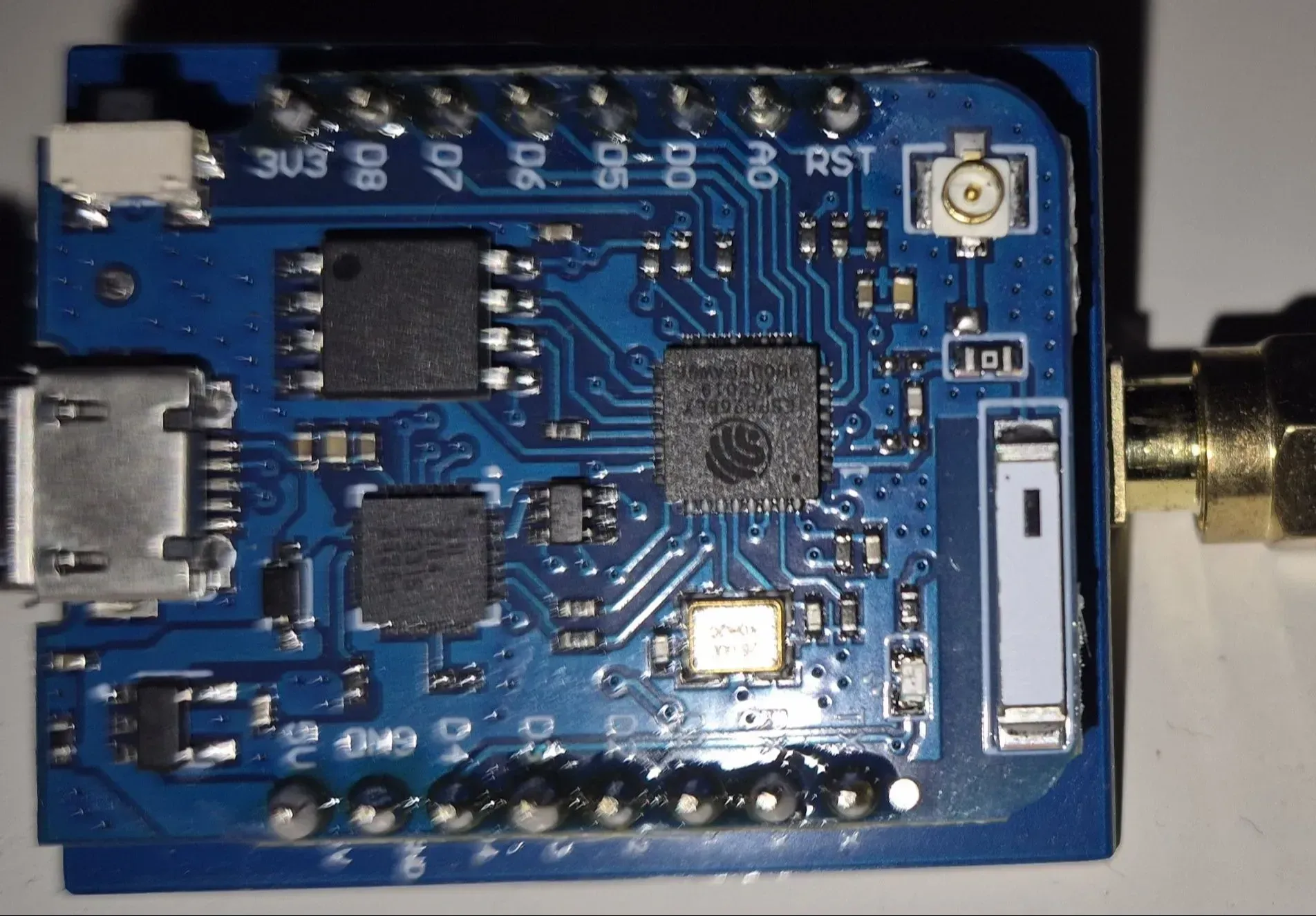 Completed
CompletedWemos Mini Pro Pocsag Transmitter v1.0
STDWemos Mini Pro Pocsag Transmitter v1.0
License
:MIT License
Description
A RadioLib-based POCSAG transmitter implementation for the CC1101 radio module with configurable frequency offset capability.
Author: Anders Isaksson (SA7BNB)
Hardware Design: Anders Isaksson
Software Development: Anders Isaksson (based on RadioLib)
This project enables transmission of POCSAG (Post Office Code Standardisation Advisory Group) pager messages using a CC1101 radio transceiver module connected to a Wemos D1 Mini Pro. The implementation includes a frequency offset feature for precise frequency calibration.
- Wemos D1 Mini Pro (or compatible ESP8266 board)
- CC1101 transceiver module
- LED (optional, for transmission indicator)
| CC1101 Pin | Wemos D1 Mini Pro Pin |
|---|---|
| CS | GPIO 15 |
| GDO0 | GPIO 4 |
| GDO2 | GPIO 2 |
| RST | Not connected |
| SCK | GPIO 14 (automatic) |
| MISO | GPIO 12 (automatic) |
| MOSI | GPIO 13 (automatic) |
| VCC | 3.3V |
| GND | GND |
LED: Connect to GPIO 5 (optional)
- Interactive Serial Interface: Send messages via serial monitor with real-time input
- Flexible Message Format: Support for both default and custom RIC (Radio Identity Code) addressing
- Frequency Offset Calibration: Adjustable frequency offset for precise tuning
- Maximum Power Output: Configured for +10 dBm output power
- Visual Feedback: LED indicator for successful transmissions
- Input Validation: Built-in checks for RIC and message validity
- Arduino IDE or PlatformIO
- RadioLib library
-
Install the RadioLib library in your Arduino IDE:
- Go to Sketch → Include Library → Manage Libraries
- Search for "RadioLib"
- Install the latest version
-
Clone or download this repository
-
Open the
.inofile in Arduino IDE -
Configure your board settings:
- Board: "LOLIN(WEMOS) D1 mini Pro"
- Upload Speed: 921600
- CPU Frequency: 80 MHz
-
Upload to your Wemos D1 Mini Pro
Adjust these parameters at the top of the code:
float BASE_FREQUENCY = 433.92; // Nominal frequency (MHz) float FREQUENCY_OFFSET = 0.015; // Offset in MHz (15 kHz)
- BASE_FREQUENCY: The nominal operating frequency
- FREQUENCY_OFFSET: Fine-tuning offset in MHz
- Positive values increase frequency
- Negative values decrease frequency
The transmitter is configured for maximum power (+10 dBm, approximately 10 mW). Modify the power setting in the code if needed:
radio.setOutputPower(10); // Range: -30 to +10 dBm
The transmitter supports two input formats:
-
With custom RIC:
RIC::Message- Example:
123456::Hello World - RIC must be between 1 and 2,097,151
- Example:
-
Without RIC:
Message- Example:
Test message - Uses default RIC 123456
- Example:
- Open the Serial Monitor (115200 baud)
- Wait for the prompt:
Enter command: - Type your message in one of the supported formats
- Press Enter to transmit
- Watch for transmission confirmation
- Maximum message length: 40 characters
- Longer messages are automatically truncated
- Only ASCII characters are supported
RadioLib POCSAG Transmitter Starting...
Base frequency: 433.92000 MHz
Frequency offset: 0.01500 MHz
Actual transmit frequency: 433.93500 MHz
[CC1101] Initializing ... success!
[Pager] Initializing ... success!
[CC1101] Setting maximum power ... MAX POWER SET!
=== POCSAG Message Sender ===
Format: RIC::Message (e.g., '123456::Hello World')
Or just: Message (uses default RIC 123456)
TX Frequency: 433.93500 MHz
Enter command: 123456::Test message
Sending: 'Test message' to RIC 123456
[Pager] Transmitting ... SUCCESS!
Message sent successfully!
- Protocol: POCSAG
- Baud Rate: 1200 bps
- Modulation: FSK (Frequency Shift Keying)
- Encoding: ASCII
- Default Frequency: 433.92 MHz (adjustable)
- RIC Range: 1 to 2,097,151 (21-bit addressing)
⚠️ Important:
- Ensure you have the appropriate license to transmit on your chosen frequency
- Respect local regulations regarding radio transmissions
- Be aware of frequency allocations in your country
- This project is intended for educational and amateur radio use only
- The author assumes no liability for misuse or regulatory violations
- Check wiring connections
- Verify power supply (3.3V for CC1101)
- Confirm antenna is connected
- Check serial monitor for error codes
- Use an SDR or spectrum analyzer to verify actual transmission frequency
- Adjust
FREQUENCY_OFFSETin small increments (0.001 MHz) - Temperature can affect frequency stability
- Verify RIC matches receiver configuration
- Confirm receiver is tuned to the correct frequency
- Check transmission power and antenna placement
This project is provided as-is for educational purposes. Please check RadioLib's license for library-specific terms.
- Hardware design and software implementation by Anders Isaksson (SA7BNB)
- Built using the excellent RadioLib by Jan Gromeš
- POCSAG protocol implementation by RadioLib contributors
- POCSAG Protocol Information
- CC1101 Datasheet
- RadioLib Documentation
- https://github.com/sa7bnb/Wemos-Mini-Pro-Pocsag-Transmitter-v1.0
Design Drawing
 The preview image was not generated, please save it again in the editor.
The preview image was not generated, please save it again in the editor.BOM
 Bom empty
Bom empty Clone
CloneProject Members
 Empty
Empty


Comment